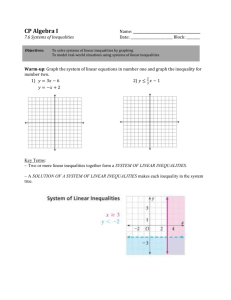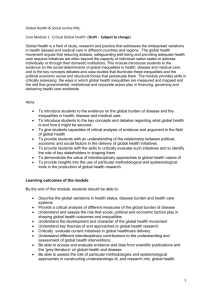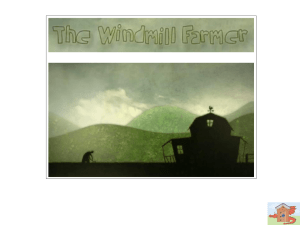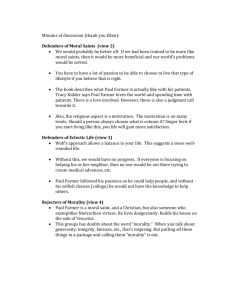The MATLAB Notebook v1.5.2
advertisement
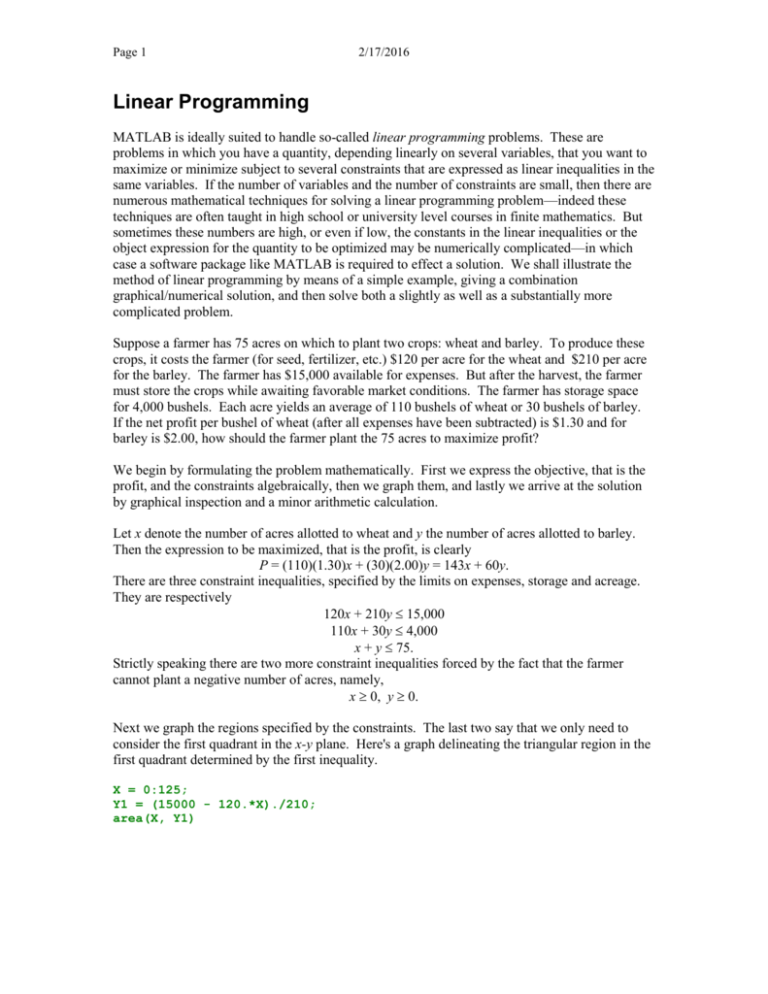
Page 1
2/17/2016
Linear Programming
MATLAB is ideally suited to handle so-called linear programming problems. These are
problems in which you have a quantity, depending linearly on several variables, that you want to
maximize or minimize subject to several constraints that are expressed as linear inequalities in the
same variables. If the number of variables and the number of constraints are small, then there are
numerous mathematical techniques for solving a linear programming problem—indeed these
techniques are often taught in high school or university level courses in finite mathematics. But
sometimes these numbers are high, or even if low, the constants in the linear inequalities or the
object expression for the quantity to be optimized may be numerically complicated—in which
case a software package like MATLAB is required to effect a solution. We shall illustrate the
method of linear programming by means of a simple example, giving a combination
graphical/numerical solution, and then solve both a slightly as well as a substantially more
complicated problem.
Suppose a farmer has 75 acres on which to plant two crops: wheat and barley. To produce these
crops, it costs the farmer (for seed, fertilizer, etc.) $120 per acre for the wheat and $210 per acre
for the barley. The farmer has $15,000 available for expenses. But after the harvest, the farmer
must store the crops while awaiting favorable market conditions. The farmer has storage space
for 4,000 bushels. Each acre yields an average of 110 bushels of wheat or 30 bushels of barley.
If the net profit per bushel of wheat (after all expenses have been subtracted) is $1.30 and for
barley is $2.00, how should the farmer plant the 75 acres to maximize profit?
We begin by formulating the problem mathematically. First we express the objective, that is the
profit, and the constraints algebraically, then we graph them, and lastly we arrive at the solution
by graphical inspection and a minor arithmetic calculation.
Let x denote the number of acres allotted to wheat and y the number of acres allotted to barley.
Then the expression to be maximized, that is the profit, is clearly
P = (110)(1.30)x + (30)(2.00)y = 143x + 60y.
There are three constraint inequalities, specified by the limits on expenses, storage and acreage.
They are respectively
120x + 210y 15,000
110x + 30y 4,000
x + y 75.
Strictly speaking there are two more constraint inequalities forced by the fact that the farmer
cannot plant a negative number of acres, namely,
x 0, y 0.
Next we graph the regions specified by the constraints. The last two say that we only need to
consider the first quadrant in the x-y plane. Here's a graph delineating the triangular region in the
first quadrant determined by the first inequality.
X = 0:125;
Y1 = (15000 - 120.*X)./210;
area(X, Y1)
Page 2
2/17/2016
80
70
60
50
40
30
20
10
0
0
20
40
60
80
100
120
Now let's put in the other two constraint inequalities.
Y2 = max((4000 - 110.*X)./30, 0);
Y3 = max(75 - X, 0);
Ytop = min([Y1; Y2; Y3]);
area(X, Ytop)
80
70
60
50
40
30
20
10
0
0
20
40
60
80
100
120
It's a little hard to see the polygonal boundary of the region clearly. Let's hone in a bit.
area(X, Ytop); axis([0 40 40 75])
75
70
65
60
55
50
45
40
0
5
10
15
20
25
30
35
40
Now let's superimpose on top of this picture a contour plot of the objective function P.
hold on
[U V] = meshgrid(0:40, 40:75);
Page 3
2/17/2016
contour(U, V, 143.*U + 60.*V); hold off
75
70
65
60
55
50
45
40
0
5
10
15
20
25
30
35
40
It seems apparent that the maximum value of P will occur on the level curve (that is, level line)
that passes through the vertex of the polygon that lies near (22,53). In fact we can compute
[x, y] = solve('x + y = 75', '110*x + 30*y = 4000')
x =
175/8
y =
425/8
double([x, y])
ans =
21.8750
53.1250
The acreage that results in the maximum profit is 21.875 for wheat and 53.125 for barley. In that
case the profit is
P = 143*x + 60*y
P =
50525/8
format bank; double(P)
ans =
6315.63
that is, $6,315.63.
This problem illustrates and is governed by the Fundamental Theorem of Linear Programming,
stated here in two variables:
A linear expression ax + by, defined over a closed bounded convex set S
whose sides are line segments, takes on its maximum value at a vertex of
S and its minimum value at a vertex of S. If S is unbounded, there may
or may not be an optimum value, but if there is, it occurs at a vertex. (A
convex set is one for which any line segment joining two points of the set
lies entirely inside the set.)
Page 4
2/17/2016
In fact MATLAB's simulink toolbox has a built-in function, simlp, that implements the solution
of a linear programming problem. The optimization toolbox has an almost identical function
called linprog. You can learn about either one from the on-line help. We will use simlp on
the above problem. After that we will use it to solve two more complicated problems involving
more variables and constraints. Here is the beginning of the output from
help simlp
SIMLP Helper function for GETXO; solves linear programming problem.
X=SIMLP(f,A,b) solves the linear programming problem:
min f'x
x
subject to:
Ax <= b
So
f = [-143 -60];
A = [120 210; 110 30; 1 1; -1 0; 0 -1];
b = [15000; 4000; 75; 0; 0];
format short; simlp(f, A, b)
ans =
21.8750
53.1250
This is the same answer we obtained before. Note that we entered the negative of the coefficient
vector for the objective function P because simlp searches for a minimum rather than a
maximum. Note also that the non-negativity constraints are accounted for in the last two rows of
A and b.
Well, we could have done this problem by hand. But suppose that the farmer is dealing with a
third crop, say corn, and that the corresponding data is:
cost per acre
yield per acre
profit per bushel
$150.75
125 bushels
$1.56.
If we denote the number of acres allotted to corn by z, then the objective function becomes
P = (110)(1.30)x + (30)(2.00)y + (125)(1.56)= 143x + 60y + 195z,
and the constraint inequalities are
120x + 210y + 150.75z 15,000
110x + 30y + 125z 4,000
x + y + z 75
x 0, y 0, z 0.
The problem is solved with simlp as follows:
clear f A b
f = [-143 -60 -195];
A = [120 210 150.75; 110 30 125; 1 1 1; -1 0 0; 0 -1 0; 0 0 -1];
b = [15000; 4000; 75; 0; 0; 0];
simlp(f, A, b)
Page 5
2/17/2016
ans =
0
56.5789
18.4211
So the farmer should ditch the wheat and plant 56.5789 acres of barley and 18.4211 acres of corn.
There is no practical limit on the number of variables and constraints that MATLAB can
handle—certainly none that the relatively unsophisticated user will encounter. Indeed, in many
true applications of the technique of linear programming, one needs to deal with many variables
and constraints. The solution of such a problem by hand is not feasible, and software like
MATLAB is crucial to success. For example, in the farming problem with which we have been
working, one could have more crops than two or three—think agribusiness instead of family
farmer. And one could have constraints that arise from other things beside expenses, storage and
acreage limitations—for example:
Availability of seed. This might lead to constraint inequalities like xj k.
Personal preferences. Thus the farmer's spouse might have a preference for one variety over
another and insist on a corresponding planting, or something similar with a collection of
crops; thus constraint inequalities like xi xj or x1 + x2 x3.
Government subsidies. It may take a moment's reflection on the reader's part, but this could
lead to inequalities like xj k.
Below is a sequence of commands that solves exactly such a problem. You should be able to
recognize the objective expression and the constraints from the data that is entered. But as an aid,
you might answer the following questions:
How many crops are under consideration?
What are the corresponding expenses? How much is available for expenses?
What are the yields in each case? What is the storage capacity?
How many acres are available?
What crops are constrained by seed limitations? To what extent?
What about preferences?
What are the minimum acreages for each crop?
clear f A b
f = [-110*1.3 -30*2.0 -125*1.56 -75*1.8 -95*.95 -100*2.25 -50*1.35];
A = [120 210 150.75 115 186 140 85; 110 30 125 75 95 100 50;
1 1 1 1 1 1 1; 1 0 0 0 0 0 0; 0 0 1 0 0 0 0; 0 0 0 0 0 1 0;
1 -1 0 0 0 0 0; 0 0 1 0 -2 0 0; 0 0 0 -1 0 -1 1;
-1 0 0 0 0 0 0; 0 -1 0 0 0 0 0; 0 0 -1 0 0 0 0; 0 0 0 -1 0 0 0;
0 0 0 0 -1 0 0; 0 0 0 0 0 -1 0; 0 0 0 0 0 0 -1];
b=[55000;40000;400;100;50;250;0;0;0;-10;-10;-10;-10;-20;-20;-20];
simlp(f, A, b)
ans =
10.0000
10.0000
40.0000
45.6522
20.0000
Page 6
2/17/2016
250.0000
20.0000
Note that despite the complexity of the problem, MATLAB solves it almost instantaneously. It
seems the farmer should bet the farm on crop number 6. We strongly suggest you alter the
expense and/or the storage limit in the problem and see what effect that has on the answer.
